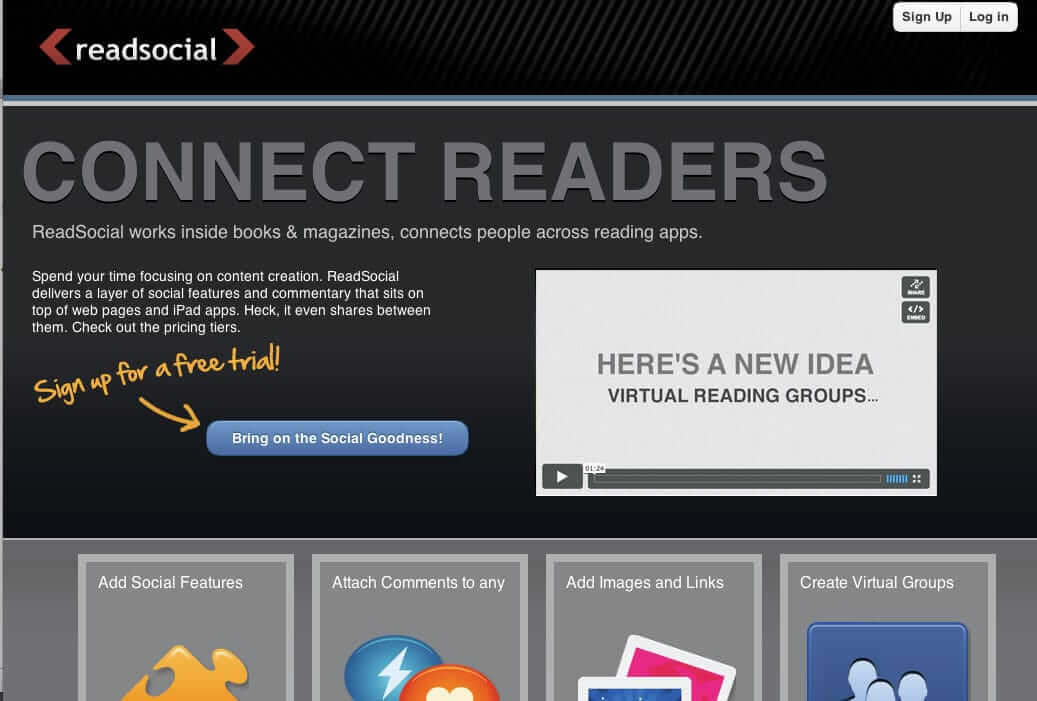
While social reading is on the rise among ebook developers, especially those who see the merits in the ability to let readers interact with each other within the confines of an academic work or textbook, the limitations of the services currently on the market left more than one API creator wanting to take social reading to the next level.
ReadSocial, which allows any content creator to add a back channel to a piece of content, is a stream of content or discussion that happens away from the main form of content, such as the ability to make annotations available as a side bar. ReadSocial partnered with Float Mobile Learning to develop the API.
“What we’ve done is we’ve taken their web API which allows any HTML page or PDF viewed on a computer and we’ve made it available on any iOS device. It’s optimized for the iPad because more reading happens there,” said Chad Udell of Float Mobile in an interview with GoodeReader. “If you have within a web browser PDF reader for iOS or an ePub reader for iOS, we can allow the discussion within the API. But if you’re a publisher, especially of things like weekly or monthly periodical or of longer content like ebooks, you can allow your book to have a back channel.”
The content that any reader can leave within the book can be text or image, URLs, and they’re soon incorporating audio and video. That information would become a piece of ReadSocial content inside the book.
“It speaks to the fact that reading has always been a social activity in how readers talk to each other about the books they’re reading. So far, none of the devices we use for digital reading have strengthened the concept of social interaction with books. This brings reading into an open format. If you look at the content that has been tagged via ReadSocial in your browser or ereader app, you see the continuity of discussion that is very unique.”
Travis Alber, the founder of ReadSocial, agrees.
“The main problem we were trying to solve is that most organizations that are trying to push content don’t want to build these features. We wanted to create an easy way for people to integrate these social features. When other companies have incorporated social features, it’s often a link to post on Facebook or Twitter, which is important, but we wanted to have ways to have conversations inside the document, as well as ways to group different people having the conversations.
“Float was incredibly helpful on the iPad side. What we did on the backend was all the logic to handle comments and quotes and a way to manage these in a dashboard. We’re currently giving away code libraries for the iPad. They look different because the iPad looks different than reading on a browser.”
“We’ve got a lot of interesting sign-ups,” Alber continues. “We’ve only had the code out there for about a month, so we haven’t seen all of the finished products live yet, but we’ve had sign-ups from textbook companies, Big Six publishers, and even magazines that have their content available on the iPad have shown an interest in developing these groups.
“Users currently sign in with Twitter and within a few weeks it will also have Facebook and Google account connectivity hopefully as early as mid-April. But we’re also enabling single use accounts for people who don’t want to sign in through another platform.
“One of the things that people find it hard to grasp is that it is not really a user-driven solution. What we wanted to do was avoid making the user do anything else. We’re partnering with the publisher or the developer, whoever is releasing the product and putting the effort on them.”
But will so-called social reading ever take the place of the traditional book club or water cooler discussion about the latest bestselling book?
“There’s no reason ebooks will be treated any differently than the way consume any other content. This is exciting because there’s a lot that can be done with it.”
Mercy Pilkington is a Senior Editor for Good e-Reader. She is also the CEO and founder of a hybrid publishing and consulting company.
